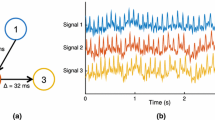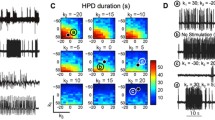Abstract
Transcranial direct current stimulation (tDCS) is a noninvasive technique that uses constant, low-intensity direct current to regulate brain activities. Clinical studies have shown that cathode-tDCS (c-tDCS) is effective in reducing seizure frequency in patients with epilepsy. Due to the heterogeneity and patient specificity of seizures, patient-specific epilepsy networks are increasingly important in exploring the regulatory role of c-tDCS. In this study, we first set the left hippocampus, para-hippocampus, and amygdala as the epileptogenic zone (EZ), and the left inferior temporal cortex and ventral temporal cortex as the initial propagation zone (PZ) to establish a large-scale epilepsy network model. Then we set tDCS cathode locations according to the maximum average energy of the simulated EEG signals and systematically study c-tDCS inhibitory effects on the propagation of epileptic activity. The results show that c-tDCS is effective in suppressing the propagation of epileptic activity. Further, to consider the patient specificity, we set specific EZ and PZ according to the clinical diagnosis of 6 patients and establish patient-specific epileptic networks. We find that c-tDCS can suppress the propagation of abnormal activity in most patient-specific epileptic networks. However, when the PZ is widely distributed in both hemispheres, the treatment effect of c-tDCS is not satisfactory. Hence, we propose dual-cathode tDCS. For epilepsy models with a wide distribution of PZ, it can inhibit the propagation of epileptiform activity in other nodes except EZ and PZ without increasing the tDCS current strength. Our results provide theoretical support for the treatment of epilepsy with tDCS.
Similar content being viewed by others
References
Commission on Classification and Terminology of the International League Against Epilepsy. Proposal for Classification of Epilepsies and Epileptic Syndromes. Epilepsia, 1985, 26: 268–278
Perucca E, French J, Bialer M. Development of new antiepileptic drugs: Challenges, incentives, and recent advances. Lancet Neurol, 2007, 6: 793–804
Téllez-Zenteno J F, Dhar R, Wiebe S. Long-term seizure outcomes following epilepsy surgery: A systematic review and meta-analysis. Brain, 2005, 128: 1188–1198
Wang Y, Schroeder G M, Sinha N, et al. Personalised network modelling in epilepsy. arXiv: 1901.01024
Rolston J D. Surgical strategies for epilepsy in eloquent areas. J Epilepsy, 2016, 2: 1
Jehi L E, Silveira D C, Bingaman W, et al. Temporal lobe epilepsy surgery failures: Predictors of seizure recurrence, yield of reevaluation, and outcome following reoperation. JNS, 2010, 113: 1186–1194
Nitsche M A, Paulus W. Excitability changes induced in the human motor cortex by weak transcranial direct current stimulation. J Physiol, 2000, 527: 633–639
Nitsche M A, Cohen L G, Wassermann E M, et al. Transcranial direct current stimulation: State of the art 2008. Brain Stimul, 2008, 1: 206–223
Brunoni A R, Nitsche M A, Bolognini N, et al. Clinical research with transcranial direct current stimulation (tDCS): Challenges and future directions. Brain Stimul, 2012, 5: 175–195
Kaufmann E, Hordt M, Lauseker M, et al. Acute effects of spaced cathodal transcranial direct current stimulation in drug resistant focal epilepsies. Clin Neurophysiol, 2021, 132: 1444–1451
Boggio P S, Rigonatti S P, Ribeiro R B, et al. A randomized, double-blind clinical trial on the efficacy of cortical direct current stimulation for the treatment of major depression. Int J Neuropsychopharmacol, 2008, 11: 249–254
Broeder S, Nackaerts E, Heremans E, et al. Transcranial direct current stimulation in Parkinson’s disease: Neurophysiological mechanisms and behavioral effects. Neurosci Biobehaval Rev, 2015, 57: 105–117
Fregni F, Boggio P S, Lima M C, et al. A sham-controlled, phase II trial of transcranial direct current stimulation for the treatment of central pain in traumatic spinal cord injury. Pain, 2006, 122: 197–209
Rajji T K. Transcranial magnetic and electrical stimulation in Alzheimer’s disease and mild cognitive impairment: A review of randomized controlled trials. Clin Pharmacol Ther, 2019, 106: 776–780
Sudbrack-Oliveira P, Barbosa M Z, Thome-Souza S, et al. Transcranial direct current stimulation (tDCS) in the management of epilepsy: A systematic review. Seizure, 2021, 86: 85–95
San-juan D, Morales-Quezada L, Orozco Garduño A J, et al. Transcranial direct current stimulation in epilepsy. Brain Stimul, 2015, 8: 455–464
Tekturk P, Erdogan E T, Kurt A, et al. The effect of transcranial direct current stimulation on seizure frequency of patients with mesial temporal lobe epilepsy with hippocampal sclerosis. Clin Neurol Neurosurg, 2016, 149: 27–32
Fregni F, Thome-Souza S, Nitsche M A, et al. A controlled clinical trial of cathodal DC polarization in patients with refractory epilepsy. Epilepsia, 2006, 47: 335–342
Auvichayapat N, Rotenberg A, Gersner R, et al. Transcranial direct current stimulation for treatment of refractory childhood focal epilepsy. Brain Stimul, 2013, 6: 696–700
Varga E T, Terney D, Atkins M D, et al. Transcranial direct current stimulation in refractory continuous spikes and waves during slow sleep: A controlled study. Epilepsy Res, 2011, 97: 142–145
Yook S W, Park S H, Seo J H, et al. Suppression ofseizure by cathodal transcranial direct current stimulation in an epileptic patient—A case report. Ann Rehabil Med, 2011, 35: 579
San-Juan D, Espinoza López D A, Vázquez Gregorio R, et al. Transcranial direct current stimulation in mesial temporal lobe epilepsy and hippocampal sclerosis. Brain Stimul, 2017, 10: 28–35
Meiron O, Gale R, Namestnic J, et al. High-definition transcranial direct current stimulation in early onset epileptic encephalopathy: A case study. Brain Injury, 2018, 32: 135–143
Meiron O, Gale R, Namestnic J, et al. Antiepileptic effects of a novel non-invasive neuromodulation treatment in a subject with early-onset epileptic encephalopathy: Case report with 20 sessions of HD-tDCS intervention. Front Neurosci, 2019, 13: 547
Rezakhani S, Amiri M, Weckhuysen S, et al. Therapeutic efficacy of seizure onset zone-targeting high-definition cathodal tDCS in patients with drug-resistant focal epilepsy. Clin Neurophysiol, 2022, 136: 219–227
Majhi S, Perc M, Ghosh D. Dynamics on higher-order networks: A review. J R Soc Interface, 2022, 19: 20220043
Parastesh F, Jafari S, Azarnoush H, et al. Chimeras. Phys Rep, 2021, 898: 1–114
Gosak M, Milojević M, Duh M, et al. Networks behind the morphology and structural design of living systems. Phys Life Rev, 2022, 41: 1–21
Ma J. Biophysical neurons, energy, and synapse controllability: A review. J Zhejiang Univ Sci A, 2022, 24: 109–129
Wu S F, Wang L B, Zhao Y W, et al. Chronic electrical stimulation induces functional network changes in cortical neuron cultures. Sci China Tech Sci, 2020, 63: 637–647
Lu H, Gallinaro J V, Rotter S. Network remodeling induced by transcranial brain stimulation: A computational model of tDCS-triggered cell assembly formation. Network Neurosci, 2019, 3: 924–943
Rahman A, Lafon B, Bikson M. Multilevel computational models for predicting the cellular effects of noninvasive brain stimulation. In: Progress in Brain Research. Elsevier, 2015. 25–40
Molaee-Ardekani B, Márquez-Ruiz J, Merlet I, et al. Effects of transcranial Direct Current Stimulation (tDCS) on cortical activity: A computational modeling study. Brain Stimul, 2013, 6: 25–39
Kunze T, Hunold A, Haueisen J, et al. Transcranial direct current stimulation changes resting state functional connectivity: A large-scale brain network modeling study. NeuroImage, 2016, 140: 174–187
Denoyer Y, Merlet I, Wendling F, et al. Modelling acute and lasting effects of tDCS on epileptic activity. J Comput Neurosci, 2020, 48: 161–176
Jirsa V K, Proix T, Perdikis D, et al. The Virtual Epileptic Patient: Individualized whole-brain models of epilepsy spread. Neuroimage, 2017, 145: 377–388
Liu Z L, Yu Y, Wang Q Y. Functional modular organization unfolded by chimera-like dynamics in a large-scale brain network model. Sci China Tech Sci, 2022, 65: 1435–1444
Coronel-Oliveros C, Cofré R, Orio P. Cholinergic neuromodulation of inhibitory interneurons facilitates functional integration in whole-brain models. PLoS Comput Biol, 2021, 17: e1008737
Yang C, Liu Z, Wang Q, et al. Epileptic seizures in a heterogeneous excitatory network with short-term plasticity. Cogn Neurodyn, 2021, 15: 43–51
Yang C, Luan G, Wang Q, et al. Localization of epileptogenic zone with the correction of pathological networks. Front Neurol, 2018, 9: 143
Kötter R. Online retrieval, processing, and visualization of primate connectivity data from the CoCoMac database. Neuroinformatics, 2004, 2: 127–144
Jansen B H, Rit V G. Electroencephalogram and visual evoked potential generation in a mathematical model of coupled cortical columns. Biol Cybern, 1995, 73: 357–366
Kulik S D, Douw L, van Dellen E, et al. Modeling of individual neurophysiological brain connectivity. Neuroscience, 2022
Sanz-Leon P, Knock S A, Spiegler A, et al. Mathematical framework for large-scale brain network modeling in The Virtual Brain. Neuroimage, 2015, 111: 385–430
Sanz Leon P, Knock S A, Woodman M M, et al. The Virtual Brain: A simulator of primate brain network dynamics. Front Neuroinform, 2013, 7: 10
Huang Y, Datta A, Bikson M, et al. Realistic volumetric-approach to simulate transcranial electric stimulation—ROAST—A fully automated open-source pipeline. J Neural Eng, 2019, 16: 056006
Pion-Tonachini L, Hsu S H, Chang C Y, et al. Online automatic artifact rejection using the real-time EEG source-mapping toolbox (REST). In: 2018 40th Annual International Conference of the IEEE Engineering in Medicine and Biology Society (EMBC). Honolulu: IEEE, 2018. 106–109
Author information
Authors and Affiliations
Corresponding authors
Additional information
This work was supported by the National Natural Science Foundation of China (Grant Nos. 12202027, 11932003, 12272092, 11972115) and the China Postdoctoral Science Foundation (Grant No. 2021TQ0025).
Supporting Information
The supporting information is available online at tech.scichina.com and link.springer.com. The supporting materials are published as submitted, without typesetting or editing. The responsibility for scientific accuracy and content remains entirely with the authors.
Electronic Supplementary Material
Rights and permissions
About this article
Cite this article
Yu, Y., Fan, Y., Han, F. et al. Transcranial direct current stimulation inhibits epileptic activity propagation in a large-scale brain network model. Sci. China Technol. Sci. 66, 3628–3638 (2023). https://doi.org/10.1007/s11431-022-2341-x
Received:
Accepted:
Published:
Issue Date:
DOI: https://doi.org/10.1007/s11431-022-2341-x




